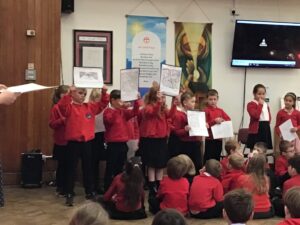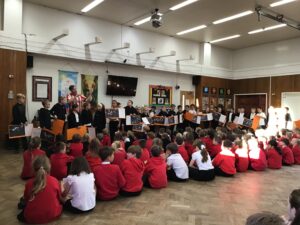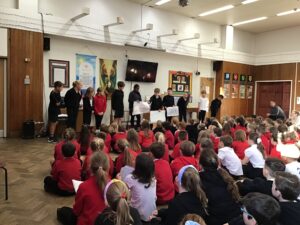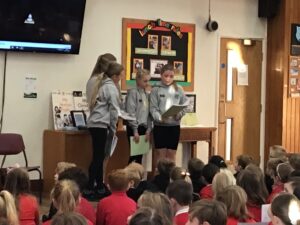Year 3 were delighted to welcome parents into school yesterday to take part in our art unit on collography. Pupils designed an image of an Ancient Greek mythical creature, transferred it onto cardboard and cut it out. We used ribbed paper and hole punches to add texture, ready to be printed using acylic paints.

October was “Geography fieldwork month” in St.Alban’s. Fieldwork is where you go outside the classroom and find things out for yourself. Over the last month, our students have had the opportunity to explore the local area and learn in a more practical, hands-on way in geography.
Each class was given a different enquiry question that they had to try and answer using a variety of progressive fieldwork skills. Children across school completed maps, surveys, time sampling, tallys, pictograms and digital mapping linked to their enquiry question. Children then used the information that they had gathered to draw their own conclusions.
Today, each class had the opportunity to present their findings to the rest of the school. Children were very adept at explaining what they did and what they found out. Well done St.Alban’s- we are all geographers!

On Thursday 16th November, we will be hosting a parent workshop explaining how we teach handwriting at St Alban’s.
From the first day of school, we pay particular attention to good writing habits. By the end of the session you will know what we mean by BBC, TNT and lots of other useful tips.
We look forward to welcoming you in the school hall at 2:15pm. Grandparents are also welcome.
Thank you,
Mrs Gurner

Today Huw Thomas from the Diocese of Sheffield, presented Bibles to year 2 and 3 children at St Alban’s Church.
Children in year 2 were presented with a picture bible that they will take home at the end of key stage one.
Children are presented with a different Bible when they move in to the juniors (year 3). This Bible stays with the children as they move classes and they take it home when they leave St Alban’s.
How will we use the Bibles?
Children use their Bibles in collective worship, religious education and engage with it weekly in class.
It was lovely to see so many parents, grandparents and friends at the service- the perfect finish to a busy week.
Thank you,
Mrs Gurner
Today in science, year 3 learnt about igneous rocks.
We used white and milk chocolate chips to show rocks in the ground. We put the chips into a bowl and put the bowl into hot water. This was like rocks being melted at the earth’s core.
The chips melted and blended together. This showed the minerals had melted. We poured the melted chocolate out which was like the molten rock coming out from inside the earth.
The molten rock solidifies and forms a new rock, called igneous rock.
In Science, year 3 have been busy making sedimentary sandwiches and metamorphic chocolate.
The different parts of the sedimentary sandwiches represented the different sediments that make up sedimentary rocks, such as dead plants, animal bones, dust and other rocks.
For metamorphic rocks, we used white and milk chocolate to help us understand how different rocks merge to form metamorphic rocks through heat.
Today in science, year 3 continued their unit on rocks. Remembering how we classified and grouped the sweetie rocks from earlier in the term, we used a variety of real rocks which we grouped into different categories according to their characteristics. These included characteristics such as smoothness, size, shine, etc.








































